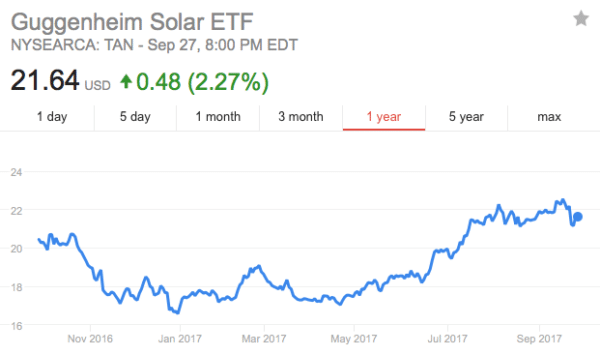In the cases made for and against trade action under the Section 201 process currently underway, both sides have argued that their respective positions are good for the U.S. solar industry and employment – even as the bulk of the public statements by U.S. solar companies have been against trade action.
However, the stock market has also spoken, with last Friday’s injury determination not exactly inspiring confidence in investors. Following the ruling, stock prices were down across a range of solar exchange traded funds (ETFs), manufacturers and installers who are exposed to the U.S. market.
Specifically, the Guggenheim Solar ETF (NASDAQ: TAN) took a sharp downward turn on Friday, as did the stock of First Solar (NASDAQ:FSLR), SunPower (SPWR), Tesla (TSLA), Sunrun (RUN) and Vivint Solar (NYSE: VSLR)
This is not to say that the market is all-knowing, or that individual investors even understand the details of the Section 201 process and potential market impacts. First Solar’s stock price decline is particularly ironic, given that its thin-film PV products are not covered under the Section 201 case, and that if anything trade action will increase the demand for its products in the U.S. market.
Likewise Canadian Solar’s stock did not show this same sharp decline, even though the company is exposed to the U.S. market both through the sale of modules and its ownership of developer Recurrent Energy. And while the big three solar installers – Tesla, Sunrun and Vivint – all saw their stock prices fall (although Tesla’s slide began the day before the ruling), the U.S. residential sector is likely to be less effected by any trade action than the commercial and industrial or utility-scale markets.
In fact, the indiscriminate market response to the ruling is reminiscent on a smaller scale of what happened to solar stocks in the first half of 2016, when stock prices plunged along with oil prices, due to a faulty association made by many investors between the price of oil and the competitiveness of solar. This may be a holdover from the 1970s when petroleum made up a significant portion of U.S. electricity generation.
 It is also important to note that the stock price declines that began on Friday are relatively small compared to the widespread gains in solar stocks over the last six months. The fall in TAN’s price was only 4% from Friday through Tuesday, compared to a nearly 20% gain from early May through mid-September.
It is also important to note that the stock price declines that began on Friday are relatively small compared to the widespread gains in solar stocks over the last six months. The fall in TAN’s price was only 4% from Friday through Tuesday, compared to a nearly 20% gain from early May through mid-September.
By Wednesday TAN’s price had made up for half of the losses.
This content is protected by copyright and may not be reused. If you want to cooperate with us and would like to reuse some of our content, please contact: editors@pv-magazine.com.









By submitting this form you agree to pv magazine using your data for the purposes of publishing your comment.
Your personal data will only be disclosed or otherwise transmitted to third parties for the purposes of spam filtering or if this is necessary for technical maintenance of the website. Any other transfer to third parties will not take place unless this is justified on the basis of applicable data protection regulations or if pv magazine is legally obliged to do so.
You may revoke this consent at any time with effect for the future, in which case your personal data will be deleted immediately. Otherwise, your data will be deleted if pv magazine has processed your request or the purpose of data storage is fulfilled.
Further information on data privacy can be found in our Data Protection Policy.